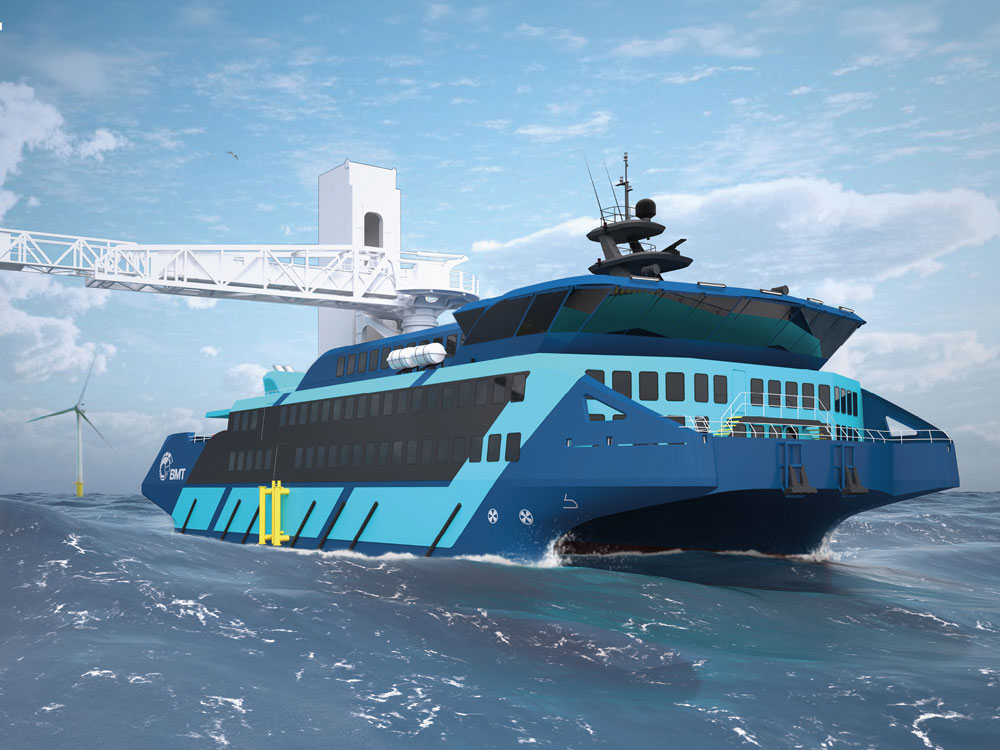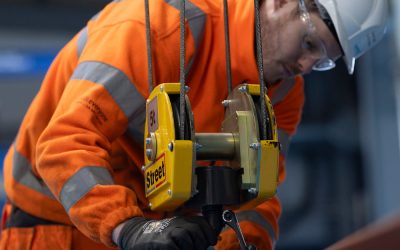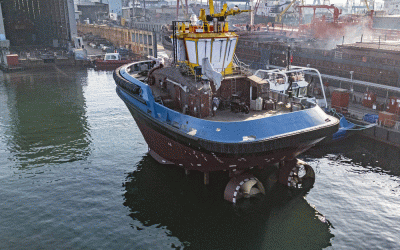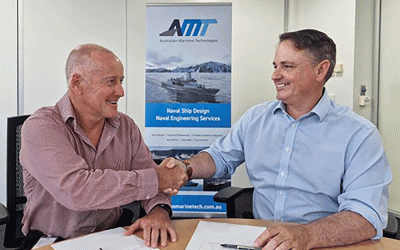While the global offshore wind market continues to thrive, support vessel operators are still under pressure to reduce overall Opex alongside reductions in emissions and fuel consumption.
One proposed solution has been the creation of a ‘halfway house’ between traditional crew transfer vessels (CTVs), which carry the turbine technicians from shore to offshore site and back, and service operation vessels (SOVs), which typically remain on station at the site, acting as offshore motherships for long-term technician deployment. While SOVs are useful in eliminating daily return trips between site and shore, they require a substantial investment.
This has prompted naval architect and designer BMT to develop the concept for a 48m-long vessel, sitting somewhere between a CTV and an SOV as a cost-effective, comfortable and operationally efficient ‘best of both worlds’. The company’s proposed 48m SOV is modelled on a diesel-electric platform and an optimised hullform, but also incorporates a methanol-ready design.
For Noel Tomlinson, global business development lead, commercial shipping at BMT, mid-sized CTV/SOV hybrids stand a good chance of becoming the ‘new normal’ in offshore wind. “There is no doubt SOVs around the 48m length will play an important part in the sector in the near term,” he tells Ship & Boat International. “Smaller SOVs are becoming increasingly relevant due to their cost efficiency and reduced environmental impact, catering well to the incredibly diverse needs of modern offshore wind farms that vary widely in scale and geographical conditions. These vessels serve not just as transportation but as multi-functional platforms—acting as hotels, storage units and workshops. This flexibility makes them invaluable for prolonged operations at sea.”
As another benefit, these mini-sized SOVs (alternatively described as ‘midi-SOVs’) involve significantly lower construction costs compared with their traditional, 70-90m-long cousins – offering “a pragmatic solution in times when budget constraints are a concern”, Tomlinson adds.
However, filling the niche between conventional CTVs and SOVs came with specific challenges. With approximately 70 CTVs under its belt to date, BMT is well-versed in this type of boat design – but lining everything up to produce a viable, smaller SOV type also required a bit of a fresh perspective. “Vessel stability is at the core of our thinking,” Tomlinson explains. “Designing the 48m SOV posed unique challenges, particularly concerning stability and safety in the harsh conditions typically managed by larger, 70m+ SOVs. In order to provide vessel operators with a broad range of operating conditions, we had to come up with a hullform that would be able to operate well and reliably in tough conditions.”
Consequently, BMT opted for a small waterplane area twin hull (SWATH) design, following an extensive parametric study. “The SWATH design was chosen for its superior stability and seakeeping capabilities, which are crucial for maintaining operational effectiveness and safety in rough waters,” Tomlinson says. This not only spells more comfortable transits for the vessel’s 40 turbine technicians and 16-strong crew, but provides a safer platform for personnel during ship-to-turbine transfers, while also minimising noise and vibrations.
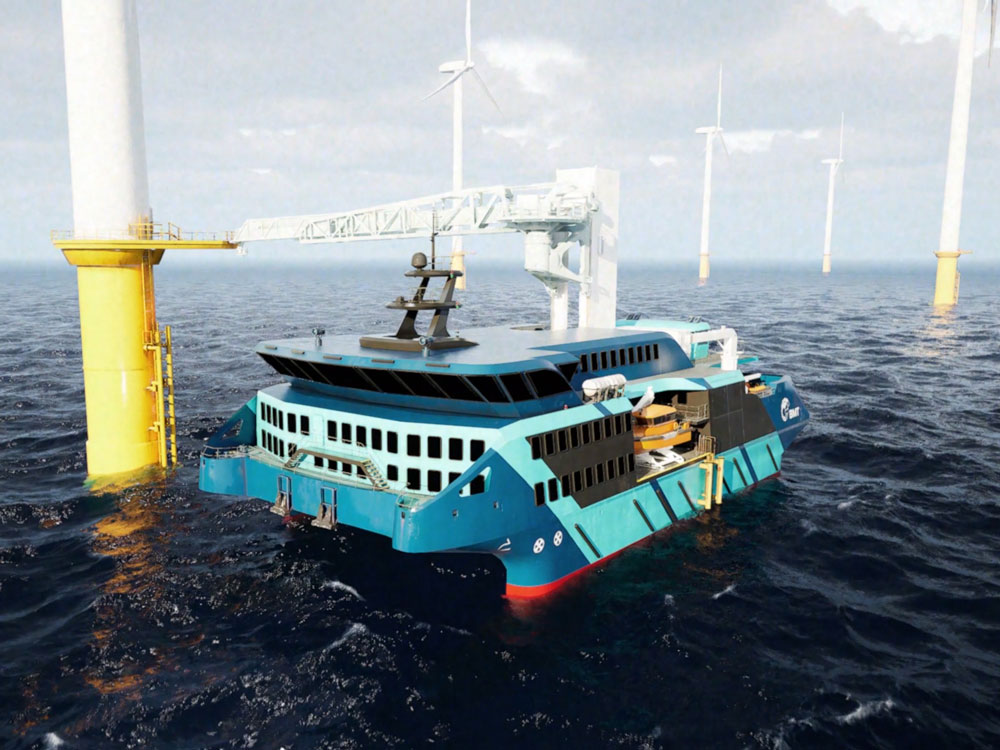
The vessel features a 30m walk-to-work gangway, a drone room and a daughter craft bay
Given the relative novelty of the midi-SOV concept, BMT worked closely with class to develop the 48m vessel. Tomilinson says: “While the SWATH design presents unique challenges, the vessel is fundamentally classed as an OSV, with additional specifications tailored to its specific roles in the offshore wind sector.” The design process saw BMT partner with walk-to-work system developer UpTime, resulting in the installation of a 30m telescopic, motion-compensated gangway for ship-to-turbine personnel transfers. The gangway also comes with an underslung crane, to enable safe transfers of small-to-medium-sized cargo.
BMT also specified an ergonomic vessel layout, for seamless, safe workflows throughout the working day. In terms of technician comfort, the vessel features spacious, single-occupancy cabins and access to entertainment hubs, lounges, a gym and a sauna.
The 48m SOV features a dedicated bay for an 8.5m daughter craft, which can assist with personnel transfers when the sea and wind are calm. Additionally, the vessel features a dedicated ‘drone room’, located on the port side, aft of the daughter craft bay. This space comes equipped with an overhead launch and recovery system (LARS) capable of launching and retrieving ROVs, AUVs and USVs of up to 5m in length. All drones are controlled from an onboard central operations room. Tomlinson highlights: “The space is also configured to support aerial drone operations, should the project requirements extend to such applications” – meaning technicians can launch UAVs to conduct turbine blade inspections.
Key to the vessel concept’s green kudos is its diesel-electric arrangement. “The propulsion system is designed to be flexible, incorporating advanced battery packs supported by high-efficiency, diesel-electric engines,” says Tomlinson. “Our approach ensures that the 48m SOV can adapt to both current and future energy requirements, with the possibility of integrating alternative fuels as they become viable.”
As mentioned, BMT is looking closely at methanol as a fuel source for this boat class, with various options on the cards. Tomlinson explains: “This design allows for the integration of methanol-ready engines, which can also be fitted with conventional engines that are adaptable to methanol with future upgrades.” As such, methanol storage tanks have been incorporated into the arrangement.
“We can adapt the vessel configuration to meet the needs of the local infrastructure,” Tomlinson adds. “While the logistics of methanol production and supply at offshore wind farms are still evolving, our engineering team is watching developments closely so we can optimise the design around the local logistical infrastructure – ensuring that our SOV designs can integrate seamlessly with existing and future methanol fuelling frameworks.”
TECHNICAL PARTICULARS: BMT 48m SOV
Length, oa: 48m / Breadth, moulded: 22m / Design draught: 5.5m / Service speed: 10knots / Max speed: 12knots / Propulsion: 2 x 1,100kW azimuthing podded propulsors / Bow thrusters: 2 x 22kW / Crew: 16 / Offshore technicians: 40 / Classification society: Bureau Veritas / Notations: AUT-UMS, SP56, SDS, Dynapos, Unrestricted Navigation, Green Passport, Cleanship
